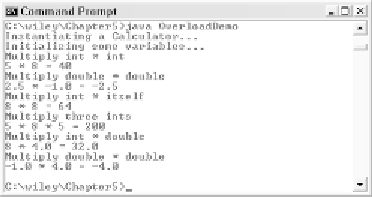Java Reference
In-Depth Information
Of the five multiply() methods in the Calculator class, the parameter lists are
different for each one. Therefore, this is an example of valid method overloading.
The following OverloadDemo program instantiates a Calculator object and
invokes the various multiply() methods. Study the OverloadDemo program
carefully and try to determine the output. The actual output is shown in Fig-
ure 5.4.
public class OverloadDemo
{
public static void main(String [] args)
{
System.out.println(“Instantiating a Calculator...”);
Calculator calc = new Calculator();
System.out.println(“Initializing some variables...”);
int a = 5;
int b = 8;
double d1 = 2.5;
double d2 = -1.0;
float f = 4.0F;
int intAnswer = 0;
double doubleAnswer = 0.0;
intAnswer = calc.multiply(a, b);
System.out.println(a + “ * “ + b + “ = “ + intAnswer);
doubleAnswer = calc.multiply(d1, d2);
System.out.println(d1 + “ * “ + d2 + “ = “ + doubleAnswer);
intAnswer = calc.multiply(b);
System.out.println(b + “ * “ + b + “ = “ + intAnswer);
intAnswer = calc.multiply(a, b, a);
System.out.println(a + “ * “ + b + “ * “ + a + “ = “
+ intAnswer);
doubleAnswer = calc.multiply(b, f);
System.out.println(b + “ * “ + f + “ = “ + doubleAnswer);
doubleAnswer = calc.multiply(d2, f);
System.out.println(d2 + “ * “ + f + “ = “ + doubleAnswer);
}
}
Figure 5.4
Output of the OverloadDemo program.


